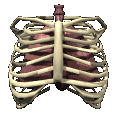When you breathe in, fresh air goes into your lungs.
Then the air goes from the lungs into your blood.
When you breathe out, stale air, called carbon dioxide, comes out of the lungs.
Getty Images
The respiratory or (breathing) system is made up of the parts of your body that take oxygen into the body, and carbon dioxide out of it.
When you breathe in through your mouth or nose, air or oxygen travels down your windpipe or trachea (say tray-kee-uh) and into your lungs. Near its end, the trachea divides into two tubes called bronchi, one into each of the lungs.
The lungs are covered with millions of tiny air sacs called alveoli (say al-vee-oh-lee) These air sacs fill with air and the lungs get bigger.
Each air sac is covered with tiny blood vessels called capillaries (say cuh-pill-ar-ees). Blood which has travelled around the body and has had all the oxygen taken from it, comes into the lungs from the heart through the blood vessels. The blood is carrying carbon dioxide which the body doesn't want. The blood leaves the carbon dioxide in the lungs and picks up fresh oxygen from the lungs. When you breathe out, the carbon dioxide leaves your body. The fresh oxygen is carried around the body in the blood.
The muscle that works the the system is called the diaphram (say di-uh-fram)
Internal organs such as the lungs and the heart are protected by the ribs. Getty Images
The lungs are protected by the ribs.
Did you know?
It is always a good idea to use more than one source of information, so here are some others for you to investigate
We breathe about 20 000 times every day. And we do it without thinking!
Read the kidcyber page about the nose
About the respiratory-system




